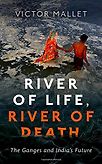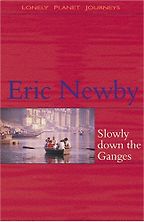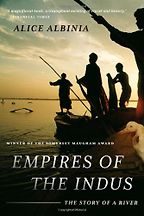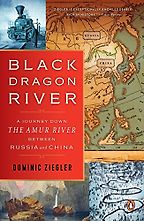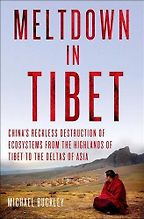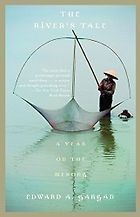As my opening gambit, why should we bother to learn about rivers at all, let alone in Asia? What do rivers tell us about the world that we live in?
Rivers and the state of them are hugely important. All civilisations depend on rivers, almost without exception. All the great cities of the world were founded on the banks of a river, from London on the Thames to Paris on the Seine, just to mention European examples. Then in Asia, you’ve got Delhi on the Yamuna, which is a tributary of the Ganges. Rivers everywhere are a source of civilisation. The reason for that is that they’re a source of life. In both pre-industrial and industrial societies they are vitally important for water, for agriculture, trade and eventually for industry. So you have a long history and prehistory of rivers’ importance to our lives.
The Ganges is, I would argue, the world’s most important river. Not because it’s the longest, which it is not by any means, but because more people depend on it and have through the ages – hundreds of millions at the moment – than on any other. It’s a densely populated part of Asia.
What else was it about the Ganges that drew you to it and telling its story in your book River of Life, River of Death?
I was based in Delhi, and I was aware that the Yamuna was a very important river running through Delhi, but nobody seemed to know much about it. Then I realised the Yamuna is a tributary of the Ganges. The Ganges is an immensely important river, spiritually as well as economically and socially, so hundreds of millions of Hindus worship the Ganges as a goddess, as a bringer of life.
Water from the Ganges can be found in Hindu households around the world. You can buy it on eBay. People send it to their relatives. They bring it from as high up the Ganges as they can go, and use it in ceremonies of death and life. But the question arose for me, if the Ganges is of such immense religious, spiritual and historical importance why is it that it is so abused by the very people who worship it and who depend on it? That mystery was quite hard to understand and very interesting to investigate.
Rivers gave birth to us, but now we are killing them.
That’s right, and they in turn are killing us. The Ganges is being heavily polluted by human sewage and toxic industrial waste. Those waters then go on to kill other people who live downstream, largely through the sewerage, which gives people diarrhoea. Roughly 1,500 Indian children a day are dying of preventable diarrhoea from poor sanitation and dirty water, and about half of those live in the Ganges basin. It’s a vicious circle.
Get the weekly Five Books newsletter
The Ganges is not dead yet by any means, unlike the Yamuna. So it is very important that we restore this river, as so many other rivers in the past have been killed and then restored again. River of Death is also a reference to the use of the Ganges in death ceremonies. If you’re a Hindu you often want your body to be cremated on the banks of the Ganges, and the ashes to be scattered in the Ganges. That’s partly what I mean by it, as well as the implication that the river is dying.
Does humanity still rely on rivers in the same way as it used to in civilisation’s early years? Surely we’re less reliant on them now?
That’s an interesting thought isn’t it? I think in highly advanced societies we might be under the illusion that we don’t depend on them very much, but in fact I would argue that we do. Although it’s probably true to say that you are less immediately dependent if you’re an advanced industrialised society, than in a country like India, where a huge proportion of the population is still engaged in agriculture, and in many cases subsistence agriculture on the flood plains of the Ganges. But even in Britain, China, or the United States, rivers remain hugely important.
When we fail to control them and fail to manage them properly it leads to catastrophic flooding and environmental disasters, which are not only expensive but damaging to human life. The countries of continental Europe have spent tens of billions of Euros cleaning up the Rhine, for example. So the health of our rivers has financial value as well as human value.
Is there a special role that rivers play for Asian countries? What is different to the role of rivers in Asia as opposed to Europe and America?
I don’t think there is a difference, except perhaps one of time. I was reading a book about the Thames the other day by Peter Ackroyd, and I hadn’t realised this but the Thames and its river confluences were once worshipped as spirits and holy places by ancient British civilisations. We have forgotten that spiritual element, whereas in India it still persists. It’s not just because India is relatively underdeveloped economically, it’s simply because of the strength of Ganges worship in Hinduism. But I would say that Asia is a Western concept – the very word came from Greece, or certainly from the West. Asia isn’t a thing in Asia.
There are many origin myths of Asian rivers, and in your book you talk us through some for the Ganges, including the toes of Vishnu. Is there the tendency in Western readers to romanticise Asian rivers and neglect their contemporary reality?
Yes, although I would argue that it’s more of a problem for Indians themselves than Westerners. Foreign visitors to India are acutely aware of the health risks of Indian rivers, and indeed many things about India. They also like the romantic, cultural and religious aspects of the Ganges. But it is Indians who are more likely to be blinded to the physical importance of the river, simply because they worship it. Because the Ganges is holy and a purifying force for life and for death – purifying you after death and ensuring that you undergo transcendence – there’s a tendency to dismiss physical pollution as unimportant.
The subtitle of your book is ‘The Ganges and India’s Future’. How does the fate of the river tell us something wider about India’s future?
The river itself is important to India’s future, but by solving some of India’s problems, you solve the river’s problems. And by solving the river’s problems you find solutions to India’s other problems. What is lacking is sensible policy and sensible implementation of policy. So it comes down to a very mundane issue of how difficult India is to govern as a country.
India is a very large country, and a democracy with lots of competing interests. Money tends to get wasted either through corruption or inefficiencies. Pollution in the Ganges is one of a host of issues that face any Indian government that comes into power. The state of the education system is catastrophic. The state of the health system is catastrophic. The justice system has severe problems. India’s democracy is wonderful, but there are many other aspects of a successful free society that are lacking. So although it doesn’t have the problems of China with authoritarianism and a one Party dictatorship, the Chinese would argue, “But we’ve solved our economic problems. We made people richer.” And that is true.
Let’s continue to float downstream with the first of your book selections, Slowly Down the Ganges by Eric Newby. Newby relates a 1,200 mile journey down the river, which he took with his wife in 1963. Why is this book on your list and what does it tell us about the Ganges?
In a way this is the book that inspired me to write mine. I read it quite a long time ago and I just love Eric Newby. It’s a travel book, but like most of his books it’s not only extremely colourful and interesting, but extremely funny. He’s the kind of writer who makes you laugh out loud when you read his words on a plane, embarrassing the people who are sitting next you. He has wonderful descriptions of waking up in the early mornings in India and listening to people coughing and hawking and spitting and going about their daily business.
“India’s democracy is wonderful, but there are many other aspects of a successful free society that are lacking”
He tried to journey as much of the Ganges as he could. He sets off not from the source, as you can’t really travel by boat down the early part of the river where it’s a rushing stream, but ironically he immediately runs aground a few yards below the first bridge where they decided to start their long boat journey. In the first six days they run aground 63 times. Of course, they come across a bunch of grasping boat sellers. Travelling is often difficult in India, and it was even more difficult then. He sometimes has to bypass parts of the river where he can’t manage it and go by train. They finish at the mouth of the Ganges in the Bay of Bengal with pilots who have guided ships for generations down the very difficult lower regions of the holy river.
How has the river changed in the last 50-plus years since it was written?
That’s interesting. I would say the main change for the river and indeed for India as a whole is the sheer growth of the Indian population. At the time of independence in 1947, the population was about a quarter of what it is now, and Newby’s book was written not that long after independence. India’s population is now between 1.3 and 1.4 billion, and India will soon be the most populous country in the world, overtaking China.
The northern part of India where the Ganges flows is very densely populated, and where population growth is exceptionally high in states like Bihar and Uttar Pradesh. Of course, all this puts enormous pressure on natural resources, including the river and its water. So you have a massive pollution load that grows every year with the growing population, from untreated sewage but also from industry.
But did you still recognise the river from his descriptions in the 1960s?
Oh yes, absolutely. Newby has a wonderful description of the Ganges in the dry season, what was essentially a pretty dried-up looking, boring river. Then the monsoon came, and the massive, huge river poured across the horizon. That extraordinary change still comes over the landscape when the Ganges goes from being a small river by most standards during the dry season, to a massive, raging torrent during the monsoon season, which thrashes its way across the countryside and is quite a stunning sight.
Yet although the natural aspects of the river are relatively unchanged, wildlife is more threatened than it was then, and the human population is much greater. One aspect that has changed in terms of river traffic is that you would be very lucky to see any kind of sailing vessel on the Ganges nowadays, whereas back in the 1960s and before, you would have seen quite a lot of sailing boats.
Let’s move across to the Indus with your second selection, Alice Albinia’s Empires of the Indus: The Story of a River. This is a journey both in space, along the river, and also in time as she tells the story of the river’s origins 5,000 years ago. What is the story of the Indus and why is it worth knowing?
This is a wonderful book. It’s an adventure story, apart from anything else. She starts at the mouth of the Indus, and heads to the source. She walks through Waziristan and she ends up in Tibet. But as you say, it’s also a journey through time, with extraordinary tangents and deviations from the river to examine lost civilisations along its banks. It’s an absolutely gripping read, extremely colourful and interesting.
She looks a bit more at history than Eric Newby does, and river worship in India today derives originally from the Indus. In early and prehistoric times it was the Indus that was worshipped, and the Ganges is the inheritor of that holy value. In fact, the name Indus comes from the Sanskrit word for a river or a big river. In Hindi the word for the Indus is the Sindhū. And then the word India comes from the Indus. So in a sense, Indians are literally river people.
Fascinating.
Alice Albinia writes about this quite a lot. She regrets that the Indus has lost its holy status to the Ganges. For example, one of the civilisations she looks at are the Mohanas, who are the Indus boat people. She says that they are identical in their equipment and sails to what is depicted on 5,000 year old seals from the ancient Mohenjo-daro kingdom or civilisation. So there is an extraordinary continuity through time.
She also has other fascinating byways that she explores, like the Siddi people who are the descendants of African slaves, and so on. Of course, there’s a lot of environmental stuff in there as well. The Indus, unlike the Ganges, is much more over exploited for irrigation. She virtually wades across the mouth of Indus. That’s just something you couldn’t do in the Ganges, thank goodness, or not so far.
What is the connection between Indian culture and rivers? It seems to be a special relationship, perhaps even more so than China or other Asian countries.
Yes, I think it is. It persists to the present and it is so strong, so intense. I think it applies in a way to all of Hinduism, which is an amazingly strong religion in the sense that its habits and practices are very little changed from thousands of years ago. Diana Eck, the Sanskrit scholar from Harvard who has written about Varanasi (Banaras), India’s sacred places, describes this very well. She says, when you go to Varanasi on the Ganges it’s a bit like going to Athens. The difference is that what you see in Varanasi is exactly what you would have seen 2,000 years ago. Of course Varanasi has motor cars, and some of the boats have motors, but then otherwise it’s remarkably unchanged, especially in terms of religious practice and bathing in the river.
So it’s primarily a religious, a Hindu connection?
Yes, although the Muslim Mughal emperors were also entranced by the purity of the water. The Ganges traditionally was regarded as a very pure source of drinking water, even by people who weren’t Hindus. The East India Company used to fill barrels with its water for the homeward trip back to Europe from Calcutta. They were impressed by the fact that the water did not go off, unlike the water that they brought in the other direction, from Europe.
Let’s meander on over to the Mekong. You’ve chosen The River’s Tale by Edward Gargan, the New York Times former correspondent, who took a year-long journey along the Mekong. What does this book tell us about another famous Asian river?
Again, this is an adventure and a travel story. Ed Gargan goes from the source of the river in Tibet, downstream towards the sea, so the opposite direction to Alice Albinia. All of these great Asian rivers are very different at their mouths from what they’re like higher up. There is a huge contrast between the high mountains where they rise and the sprawling muddy deltas where they meet the sea. Just incidentally, I was told by a Hindu scholar that the word Mekong is actually connected to the Ganges – Ma Ganga became Mekong. Unfortunately I can’t find any evidence to prove that this is correct, so I haven’t put it in my book, but it’s an interesting idea and a lot of Indians think that it is the case.
It can be an exclusive to Five Books.
It’s one of those things that is hard to prove. I’m not sure that I ever found out the actual source of the name. But it’s an interesting tale. There’s another intriguing thing in both Alice Albinia’s and Ed Gargan’s books: when they’re at the upper reaches of their rivers, the Indus and the Mekong, they both come across places in Tibet where the river has been stopped dead in its tracks by a dam. The shock is overwhelming. These rivers have been there for millennia, and then it’s just not there anymore, because it has been dammed, in both cases by the Chinese. I quote both in my book, because it’s very striking how man has messed with our natural environment. Even the great rivers of the world are stopped in their tracks and used for hydroelectricity or irrigation, and of course below these dams the river is dry or nearly dry.
Let’s head north to Black Dragon River: A Journey Down the Amur by Dom Ziegler. The ‘Black Dragon’ is the literal translation of the Chinese word for it, the Heilongjiang, which acts as part of the border between the great empires of Russia and China.
This is a fascinating guide into the most obscure, intriguing parts of Russian and Chinese, East Asian and Siberian history that I knew absolutely nothing about. It’s quite an eccentric venture, because it’s extremely difficult to travel along the Amur River. In very remote places, unlike the Ganges, it’s not heavily populated along most of its length, running through Siberian areas. There are very few people around when Ziegler first sees it, from an aircraft. He looks down, sees a magnificent river winding its way through Siberia, and realises there’s no one living along it. Of course, he’s immediately fascinated.
It’s also so damn cold up there.
It’s extremely cold and hostile, and also politically hostile because neither the Russians nor the Chinese are very much in favour of journalists wandering around their border regions, asking awkward questions about their rivers, so you can imagine how difficult it was. I think all of the travellers who have gone down the river have had a very difficult time getting access. Dominic Ziegler arguably had the most demanding time, simply getting visas and permission.
“Neither the Russians nor the Chinese are very much in favour of journalists wandering around their border regions, asking awkward questions”
Ziegler is also fascinated by wildlife. He’s particularly interested in birds and studies the cranes that are found along the Amur River. By virtue of its isolation, the Amur is an area of great natural beauty. But when he’s there, he discovers bizarre and intriguing parts of 19th century Russian history, about how the Russians have grabbed territory in what is now Eastern Siberia, but used to be known as Outer Manchuria.
So the river is a symbol for fraught relations between Russia and China?
Politically, the Russians and the Chinese are arguing about whether the river rises in China or in Russia. They get all of these huge maps and study them for many days, then they discover that actually the true source of the river, if you take the furthest point away from the mouth, is in Mongolia.
The Amur is not the only river which doubles as a national border. How effective are rivers at being borders, especially when you can swim across them or in some cases walk across them?
The river that has been probably most talked about recently in that regard is the Yalu, which forms the border between North Korea and China. In places the Yalu is very narrow and freezes over, and people have for many years walked across to China and eventually to freedom. So I guess when a river is frozen it’s not a very effective border.
There are also potential disputes between upstream and downstream states. For example, the Indus actually rises in China but then runs through a part of what is now India and then into Pakistan, so potential sources of conflict are often there.
Let’s explore them, and swim upstream to Tibet where all the great Asian rivers are born, and many others as well. In Michael Buckley’s book Meltdown in Tibet he explores some of the environmental and also the political consequences of the ‘upstream problem,’ as you put it. Could you introduce this book and its argument?
This book is not quite as elegantly written as the other four, not as poetic, but it is incredibly important, covering an extremely relevant topic. Essentially it is a polemic, accusing modern-day China of committing ecocide at the sources of the five great rivers: the Indus, the Brahmaputra, which joins the Ganges lower down, the Irrawaddi, which goes into Myanmar, the Mekong and the Yangtze. Two billion people in Asia depend on these rivers, and China, which controls Tibet where they all rise, is doing a lot of damage.
“These are the astonishingly grandiose mega-projects which could have a devastating effect on downstream states”
I don’t think Buckley can be accused of exaggerating the risks. Only yesterday I was reading in a newspaper here in Hong Kong, the South China Morning Post, that Chinese scientists plan to build a 1,000 kilometre long tunnel to take water from the Yarlung Tsangpo, which is what they call the Brahmaputra, and take it to Xinjiang, a very dry part of Western China. These are the sort of astonishingly grandiose mega-projects which could have a devastating effect on downstream states, which in the case of the Brahmaputra would be India and Bangladesh.
In India there have been public outcries about what China is doing to its rivers upstream.
Yes. The Ganges is partly immune, as it is only joined by the Brahmaputra very far down the river in what is now Bangladesh. But the Brahmaputra does run through Assam and so you have an issue there. There is a lot of tension on this very long unmarked border in the Himalayas between India and China.
There’s also a related issue of climate change. The Tibetan Plateau is known as the third Pole, because it has so much ice locked into some 37,000 glaciers, which are all melting, or at least the lower ones are. If you go to the Himalayas, climate change is not theoretical, it is happening. In particular, the climate south of the Himalayas is already quite drastically affected by global warming, and according to some scientists the most drastic temperature changes in the planet will be there.
What is the impact of this meltdown of Himalayan snow caps on rivers. Does it cause flooding?
I’m not so sure about the other rivers, but I imagine it’s the same. Traditionally what happens is that in the dry season a river has a certain flow that comes from melting ice. But if the ice is all melted already then you’re not going to get that melting ice in the summer, and the dry season flow disappears to almost nothing. That’s very damaging for humans but also for wildlife and for the environment as a whole. And we haven’t discussed the issue of ground water, which is very important, as you need a more even supply of water down the rivers throughout the year than you would have if the ice caps weren’t melting in Tibet. Obviously, China is not the only nation responsible for global warming, but they are in charge of Tibet and are damming a lot of these rivers.
There’s a strong environmental message in your book. The implication of River of Death is that the river is dying. What can we do to fix the situation?
I try not to be too pessimistic. The Ganges is not dead yet, although some of its tributaries are dead in places. It is heavily polluted in places by industrial waste and by sewage, but it lives on and freshwater dolphins are found quite high upstream in the Ganges to this day. You also have surviving populations of the gharial, the very rare Gangetic crocodile, so all is not lost.
The message I try to get across is that you can save rivers. It has been done with the Thames in London, and with the Rhine, as well as with American rivers like the Chicago River. These rivers were pretty filthy, certainly in the case of the Thames and the Chicago River, but they have been restored to more or less complete health, and certainly that’s the case in London. A lot of people, when you talk about cleaning a river, imagine scrubbing the river somehow and getting rid of the dirt. But it’s not like that. All you have to do to clean a river is stop polluting it and the river cleans itself. You might make a slight exception for the heavy metals that lie in the sediment beneath the river, but essentially if you stop polluting a river, the natural flow of the river will clean it and you will end up with a river that is more or less pristine. It’s not that hard, but it does cost money to build sewage plants and it does take political will.
“All you have to do to clean a river is stop polluting it and the river cleans itself”
My argument is that there are so many benefits to doing this, for example with the Ganges, if you clean the river, you save the lives of people who don’t die from unnecessary diseases caused by poor sanitation. That’s an immediate benefit. You also create thousands of jobs, which India is badly needed for its young unskilled people. There are economic benefits, social benefits, and you save the river for its spiritual purposes, for religious ceremonies and bathing. As Diana Eck, the Sanskrit scholar, says, India should be or is the country where saving rivers is most important because of the spiritual element.
So having given birth to human civilisation, we need now to take better care of rivers in their old age?
And in turn they will carry on giving us life, and great pleasure as well. One of the things that Eric Newby says very simply at the start of his book is, “I love rivers.” I think we all do. If you go to a new city, one of the nicest things to do is to walk along the river, wherever it is. Whether it’s the Potomac in Washington DC or the Seine in Paris, you feel you understand the city much better. It’s a great thing to walk past Notre Dame on the Île de la Cité in the middle of Paris and see the Seine flowing down towards the sea past this great cathedral, in the old centre of Paris. Or it’s the same with the Tower of London on the Thames. Our histories are founded on the banks of these great rivers. To have them as disgusting drains, which is what the Yamuna has become in Delhi, is deeply sad and quite damaging I think – socially, spiritually, as well as in terms of human health.
Murky waters.
Indeed.
Five Books aims to keep its book recommendations and interviews up to date. If you are the interviewee and would like to update your choice of books (or even just what you say about them) please email us at [email protected]
Five Books interviews are expensive to produce. If you've enjoyed this interview, please support us by donating a small amount.

